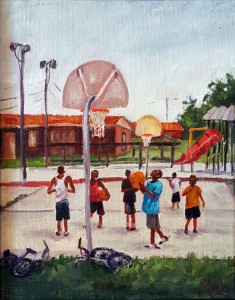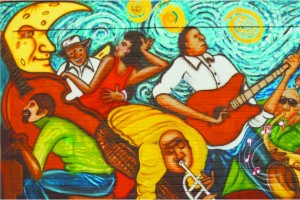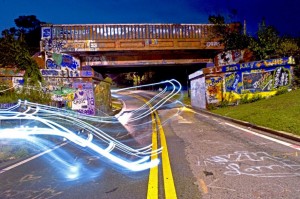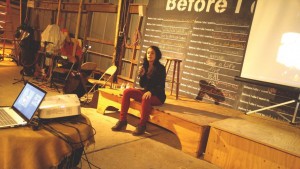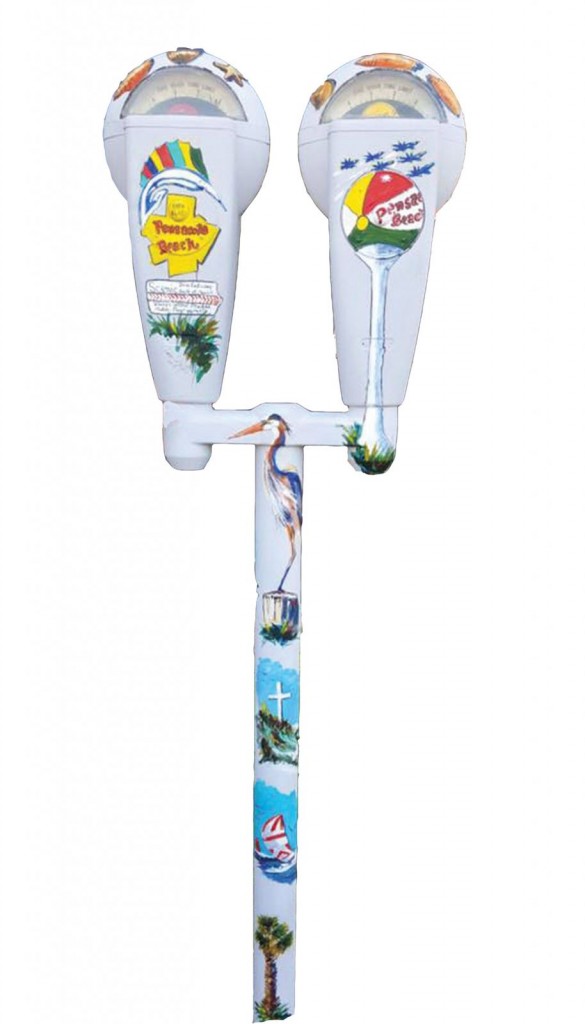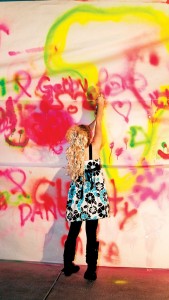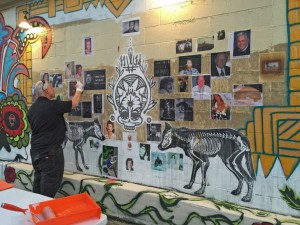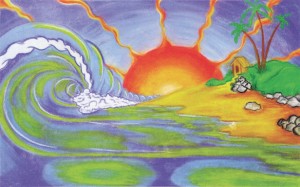With numerous organizations and institutions focused on artistic expression, and countless more artists working everyday to tell their story through brushstrokes, poetry, dance and more, Pensacola is alive with art.
Our story—and the nation’s story—is brought to gritty life on the graffiti bridge. In Brownsville, an entire neighborhood has been revitalized with art’s power. In Belmont-Devilliers, our sometimes-pretty and sometimes-ugly history with race relations is beautifully displayed against the brick of historic buildings. Just a few blocks away, people discuss life’s purpose and the meaning behind visual craftwork in a facilitated dialogue in which all are welcome to participate.
Public art is unorganized, often messy and a blunt expression of raw emotion. Public artists express their feelings and tell their stories in fervent fits of our human necessity to communicate. The result is a face-value commentary of our collective primal experience told through the prism of one person’s perspective. It is rarely subtle, but why should it have to be? It is complexity disguised as simplicity.
In celebration of all the dirty, beautiful, sordid, sexy ways we engage with each other in visual conversation, Pensacola Magazine presents a host of public art projects that have furthered that dialogue. Some are high-minded, some are inexperienced, but all are art.
Brownsville Murals
In 2010, Escambia’s Community Redevelopment Agency (CRA) was at a conference in Philadelphia. As part of the conference, they were taken on a tour of a distressed area of town that had been revitalized thanks to a community festival and contest that encouraged citizens of that area to paint murals on buildings. It wasn’t long before people were taking pride in their community, reflecting on its past and hoping for a better future. The community turned around gradually, and Clara Long, CRA division manager, thought it would be a great idea to implement a similar project in Brownsville, an area in west Pensacola that has long suffered with generational poverty and poor infrastructure.
“It has brought the community closer already,” said Long. “We don’t have many buildings, though, so we do temporary murals throughout the year.”
The CRA partners with Lamar Advertising and Artel Gallery to bring together artists for the project. Lamar prints the pieces on vinyl so that they are long-lasting and weather-resistant.
Community members submit their artwork to a jury who then selects the winners. The first year, there were seven winners. In 2016, they look to have around five. Recently, they partnered with schools in the area to get kids involved, which lends a unique, hopeful, innocent perspective to the area’s blight.
“Their love of Brownsville shines through in all the pieces,” said Long. “We will often focus on scenery or faces or some other theme, but the expression is always one of love and pride.”
The result has been incrementally transformative for the area. These residents, who work or go to school all day, who often go through life with financial disability, no longer wish to escape their surroundings. Rather, they seek to make their surroundings better. That’s the power of the new perspective that art provides.
Belmont-Devilliers Murals
It took four years to plan the Cultural Heritage Mural Project in the historic Belmont-DeVilliers district, but when it finally happened, it served as both a source of community pride and history, as well as an artistic destination for those unfamiliar with the neighborhood.
The first installed mural depicted the business history of the area, and was placed at 314 North DeVilliers St. Once a thriving African-American community that was the economic engine of the area, it has since deteriorated into neglect. This first mural served to remind residents of the greatness that once was while serving as a strategic piece of inspirational messaging.
It seems to have worked. Since 2009 with the opening of Five Sisters and UWF’s Innovation Institute, the Belmont area is becoming the hub of business and entrepreneurship it once was—all because of art.
Graffiti Bridge
Perhaps the most obvious example of unorganized, constantly shifting artistic expression in the city is the graffiti bridge. The unofficial, inelegant railroad trestle of a graffiti bridge is nothing remarkable in itself, but as a medium, it is perfect as a socially constructed outdoor installation.
Someone who has taken it upon herself to further legitimize the bridge as an actual art piece is Rachael Pongetti. She has been an art instructor for Pensacola State College, the University of West Florida, the Pensacola Museum of Art and the PACE Center for Girls. She had long known of the bridge, as many in Pensacola do, but she didn’t pay special attention to it until she and a friend had the idea to photograph it as part of a project that later resulted in an installation at the museum and a book of pictures taken each day for a year called Layers and available in January.
“The way I’m able to process change most directly is through my lens,” said Pongetti. “The bridge changes every day and I was able to learn to watch all that comes from change. Sometimes the bridge was artistic and beautiful; other times there was something very un-artistic there. So you find all of these range of emotions that you’re going though and I was learning to really observe the change instead of becoming attached to it.”
Over the past few months, plucky people both young and old have painted the bridge to reflect national movements like Black Lives Matter, national frustrations like Donald Trump, local issues like food trucks, and even to jovially argue about team rivalries and proudly declare loves both new and long-lasting. To Pongetti, the indelicate profanities and insults between ex-lovers were as important as the big statements of national concern.
“They are all aspects of the seasons of our lives,” said Pongetti. “That change and that emotion is abrupt. It was such a metaphor for life, really. What it taught me was that even though somebody’s story is covered up and changed it’s really never gone, and that’s the same with people. People’s lives and their stories are written on that bridge and they tell something that’s very important, and even though it’s gone in a matter of a few hours, it’s really not gone; it simply became a layer.”
Pecha Kucha Pensacola
Pecha Kucha is an international dialogue-based public art project, started in Tokyo. Born out of the fact that meetings simply take too long, an architectural firm created what later became known as the 20×20 format. Essentially, each presenter shows 20 images or slides, at 20 seconds each. This more dynamic and fast-paced format soon spread throughout the business world before finding its true home in the art world. The first Pecha Kucha night was hosted in 2003.
Cities around the world have adopted this novel speaking concept and adapted it for their own purposes. To be officially sanctioned, a local individual must simply reach out to Pecha Kucha Global and ask permission. Guidelines include things like recording all speakers, posting them online, and holding at least four events per contract-year.
Pensacola got its first Pecha Kucha, or PKN, in November of 2014. It was held as a side event to First City Art Center’s Hot Glass Cold Brew and soon gained in popularity so much that it has become a separate event.
“The intent was to involve creative people in a creative space and engage the community into something that could be built up from the momentum and flourish that Pensacola has been sustaining with the artists for a while now,” said Felipe Munoz, the local chapter co-organizer.
The event is free and open to all people. Those who have spoken before are invited to each event, but other that, everyone is a guest.
“The event is all about connections,” said Munoz. “Connections of ideas, of people, connection of relationships and community.”
Each talk is around seven minutes, and after a few there is a break where guests can reflect on and discuss what they just heard. As per the guidelines, PKN is about thinking and drinking. Everyone from political advocates and anthropologists, to journalists and stage dancers speak.
“If we’re lucky, we have a handful of friends to listen to our ideas,” said Liam Dunaway, a sometimes-speaker. “But PKN widens that circle. It offers you a moment to share with others in a calm and immediate setting (something very different from the “sharing” we do on social media). It’s the gift of an audience, a community of listeners for your idea, your story, your project. That’s uplifting, encouraging; it’s something very special to have in our world today.”
A Better Way to Give
Great art doesn’t just promote a viewpoint or start a conversation, though. Often it makes tangible impact in the real world. That’s part of the goal with the Pensacola Chamber’s Leadership Pensacola program. They have made it their 2016 mission to address homelessness, panhandling, and the difference between the two with their Better Way to Give class project.
As part of the initiative, dozens of colorfully-decorated, artistically-adorned meters will soon be installed in downtown Pensacola in an effort to improve the lives of the city’s homeless. Inspired by similar programs around the country, A Better Way to Give recycles obsolete parking meters, donated by the Downtown Improvement Board, providing an alternative to giving to panhandlers. This project creates a single funding source to amplify the resources available to existing programs and agencies with a proven track record of success.
Local painters like Nina Fritz and anyone else who wants to participate will get to come out to First City Art Center and try their hand at painting these meters. The hope is that these attention-getting “donation stations” will make downtown a little more colorful while also addressing what has become a huge concern in the area.
The LeaP class also plans to work with local churches, non-profit organizations and government entities to create a network of help for the homeless and education for the community. Approximately 38 meters will be installed in early 2016. The class also intends to launch an education campaign about the true causes of homelessness via media partners, social media and meter-painting parties.
Gallery Night Graffiti Wall
Every third Friday of the month, kids and adults alike go to downtown Pensacola for some legal graffiti at the corner of Romana and Palafox. The massive wall serves as a canvas for all the colorful musings and nonsensical swirls that the citizens and visitors wish to apply. As the night goes on, music begins reverberating in the alley as impromptu dance competitions break out, while the smell of spray paint and aerosol bursts lend the spectacle a distinctly urban feel.
Joe Zarzaur started the legal graffiti wall a few years ago as a way to raise money for Legal Services of North Florida, which provides free civil legal services to those who cannot afford it. Donations are not necessary but appreciated by all who wish to do good in the community while spreading whimsical expressions of creative skill and imagination.
Day of the Dead
First City Art Center (FCAC) has always taken an industrial, social stand on art. Their warehouse proudly displays the tools of the craft as prominently as the craft itself, and exists to bring alive the artist in all of us. It is from that spirit that several FCAC participants formed a new group, Art Beyond Walls, tasked with enhancing the community through public art.
“Our vision is for a collaborative spirit between artists, businesses, community members and neighborhoods to actively support the creation of site-specific murals and public artworks that will engage, educate and inspire,” said Rachael Pongetti, who helped spearhead the development of the group.
For one of its first projects, Art Beyond Walls wanted to bring a piece of the Long Hollow neighborhood to life by celebrating the lives of those who had passed.
“Community members were invited to bring a laser print of a loved one to be wheat pasted within a mural painted by local artists,” Pongetti explained. “Participants learned the how-to of wheat pasting and actually pasted their image to the wall.”
The project was called Day of the Dead and it became a community-inspired remembrance wall. The impetus for this initiative came partly from Michele MacNeil, who serves on the board at FCAC and also helped get Art Beyond Walls off the ground.
“We wanted to create a place where people could join one another and bring the heaviness of their heats,” said MacNeil.
The Day of the Dead mural was a huge success, and created a dialogue around death and life that actually spurned another project, called Before I Die.
Before I Die
An offspring of Art Beyond Walls, the local Before I Die project took a page from public art in other cities, most notably New Orleans. The project encourages people to write down bucket list items that they wish to accomplish before they do, and posts the results as a huge installation in a public space for others to converse over.
Life and death are among the rawest, most essential facets of artwork, and few projects bring the reality of death and the shortness yet possibility of life to the forefront of our minds as effectively as this project.
According to Michelle MacNeil, who helps out with Art Beyond Walls, writing these items down is a visceral reminder to get moving on the things that truly matter to us. So often the day-to-day humdrum of our lives can drag us down into immobility so much so that we forget to lead a life truly worth living. Before I Die facilitates a dialogue about these big existential issues in a no-pressure way that inspires and motivates even the most stationary among us.
Chalk It Up!
Far removed from the noble and idealistic goals of some of these other projects, Chalk It Up is a chance for professional and amateur creators alike to come out and just stain the sidewalk near Commendencia Slip however they see fit. Sometimes the result is breath-taking and beautiful; other times, not so much. But the young and young at heart always have a good time learning something new and showing off their masterpiece.
Modeled after a similar event in Savannah, Ga., the local show draws as many as a hundred artists annually. And it’s for a great cause. Each year, Chalk It Up donates to a local non-profit whose goal it is to sustain the educational and artistic presence in Pensacola.
As with any artistic competition, no matter how fun-spirited, there are best-of categories to try to win in. Winners have included architects, a high school teacher, and several self-taught chalk enthusiasts.
With live music during the competition, as well as food and drink vendors, Chalk It Up is a great opportunity to let loose and just draw something fun. In so doing, Pensacola becomes a little brighter and a little happier. And if that’s not the true point of art, well, we don’t know what is.
